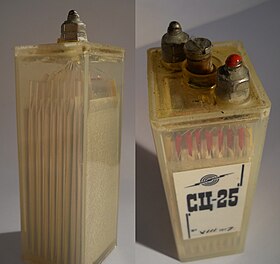Silver-zinc accumulator
A silver-zinc accumulator is a very expensive accumulator with a short service life, which achieves a very high capacity with a low volume and weight. The nominal voltage of a cell is 1.5 volts.
construction
In the discharged state of the silver-zinc accumulator, the positive electrode consists of silver (Ag) and the negative electrode consists of zinc hydroxide (Zn (OH) 2 ). When charged, the positive electrode consists of silver (I, III) oxide (Ag 2 O 2 ) and the negative electrode of zinc (Zn). When electrolyte is potassium hydroxide (KOH) of density 1.4 g / cc was used.
Chemical processes
The following chemical processes take place during charging:
When unloading, the processes run in the opposite direction.
When charging, the concentration of the electrolyte decreases due to the formation of water molecules. This can be used to determine the state of charge , as with the lead accumulator , in which the change in density takes place in reverse order.
General technical data (1968)
- Nominal voltage: 1.5V
- Initial charge voltage: 1.65V
- Final charging voltage: 2.1 V
- Initial discharge voltage: 1.65V
- Final discharge voltage: 1.0 V
- Normal charge: 12 hours with 0.1 A / Ah
- Fast charging: 2.5 hours with 0.4 A / Ah (only in urgent cases!)
- Normal discharge: 5 hours with 0.2 A / Ah
- Fast discharge: 5 minutes with 5 A / Ah
- Energy density : 65–210 Wh / kg corresponds to 0.23 to 0.76 MJ / kg
- Internal resistance: about 2 mOhm / Ah
- Lifespan: 50 to 100 cycles or 1 year
- Temperature behavior:
- at +20 ° C - nominal capacity
- at +30 ° C - about 85% of the nominal capacity
- at −20 ° C - about 50% of the nominal capacity
advantages
- high capacity (approx. 120 Ah per dm³, approx. 90 Ah per kg)
- very high short-term current pulses (over 1000 A / Ah are possible)
- low self-discharge (about 25% after one year)
- Less toxic / environmentally harmful substances
disadvantage
- high price
- short lifespan
- very sensitive to overcharging
- Memory effect
application
The silver-zinc accumulator was or is used especially in mobile mini radios. The drive batteries of the DM2A4 Hake torpedo used by the German Navy are also based on silver-zinc technology. Due to the low power-to-weight ratio , various satellites and spacecraft, such as the first artificial Earth satellite Sputnik 1 , the Apollo lunar module and the lunar rover of the Apollo program , were equipped with a silver-zinc battery.
Further development
The Californian manufacturer ZPower has been working on the further development of the silver-zinc accumulator for several years, wants to have solved some of the problems mentioned and to be able to guarantee high recyclability.
literature
- Dieter Franz: The practical radio amateur 79 / chemical power sources - German military publishing house , Berlin 1968
Individual evidence
- ↑ Jürgen Falbe, Manfred Regitz (ed.): CD Römpp Chemie Lexikon , Thieme, Stuttgart, 1995.
- ↑ navweaps.com: German Torpedoes Post World War II
- ↑ website of ZPower


